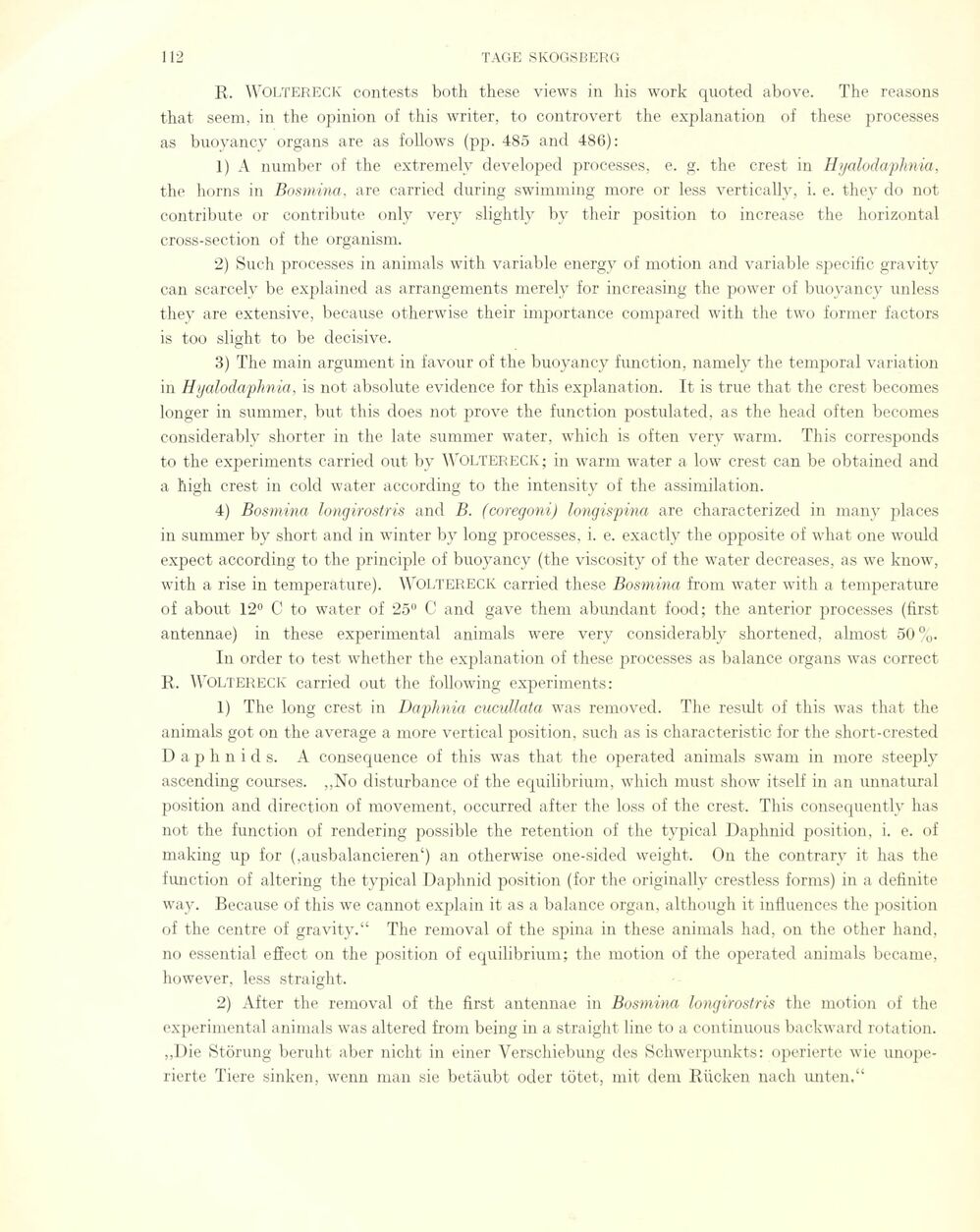
Full resolution (JPEG) - On this page / på denna sida - Sidor ...

<< prev. page << föreg. sida << >> nästa sida >> next page >>
Below is the raw OCR text
from the above scanned image.
Do you see an error? Proofread the page now!
Här nedan syns maskintolkade texten från faksimilbilden ovan.
Ser du något fel? Korrekturläs sidan nu!
This page has never been proofread. / Denna sida har aldrig korrekturlästs.
R. WOLTERECK contests both these views in bis work quoted above. The reasons
that seem, in the opinion of this writer, to controvert the explanation of these processes
as buoyancy organs are as follows (pp. 485 and 486):
1) A number of the extremelv developed processes, e. g. the crest in Hyalodaphnia,
the horns in Bosmina, are carried during swimming more or less vertically, i. e. they do not
contribute or contribute only very slightly by their position to increase the horizontal
cross-section of the organism.
2) Such processes in animais with variable energy of motion and variable specific gravity
can scarcely be expiained as arrangements merely for increasing the power of buoyancy unless
they are extensive, because otherwise their importance compared with the two former factors
is too slight to be decisive.
3) The main argument in favour of the buoyancy function, namely the temporal variation
in Hyalodaphnia, is not absolute evidence for this explanation. It is true that the crest becomes
longer in summer, but this does not prove the function postulated, as the head often becomes
considerably shorter in the late summer water, which is often very warm. This corresponds
to the experiments carried out by WOLTERECK; in warm water a low crest can be obtained and
a high crest in cold water according to the intensity of the assimilation.
4) Bosmina longirostris and B. (coregoni) longispina are characterized in many places
in summer by short and in winter by long processes, i. e. exactly the opposite of what one woulcl
expect according to the principle of buoyancy (the viscosity of the water decreases, as we know,
with a rise in temperature). WOLTERECK carried these Bosmina from water with a temperature
of about 12° C to water of 25° C and gave them abundant food; the anterior processes (first
antennae) in these experimental animais were very considerably shortened, almost 50%.
In order to test whether the explanation of these processes as balance organs was correct
R. WOLTERECK carried out the following experiments:
1) The long crest in Daphnia cucullata was removed. The result of this was that the
animais got on the average a more vertical position, such as is characteristic for the short-crested
D a p h n i d s. A conséquence of this was that the operated animais swam in more steeply
ascending courses. ,,No disturbance of the equilibrium, which must show itself in an unnatural
position and direction of movement, occurred after the loss of the crest. This consequently has
not the function of rendering possible the retention of the typical Daphnici position, i. e. of
making up for (,ausbalancieren1) an otherwise one-sided weight. On the contrary it has the
function of altering the typical Daphnid position (for the originally crestless forms) in a definite
way. Because of this we cannot explain it as a balance organ, although it influences the position
of the centre of gravity.“ The removal of the spina in these animais had, on the other hand,
no essential efïect on the position of equilibrium; the motion of the operated animais became,
however, less straight.
2) After the removal of the first antennae in Bosmina longirostris the motion of the
experimental animais was altered from being in a straight line to a continuons backward rotation.
„Die Störung beruht aber nicht in einer Verschiebung des Schwerpunkts: operierte wie
unope-rierte Tiere sinken, wenn man sie betäubt oder tötet, mit dem Rücken nach unten.“
<< prev. page << föreg. sida << >> nästa sida >> next page >>